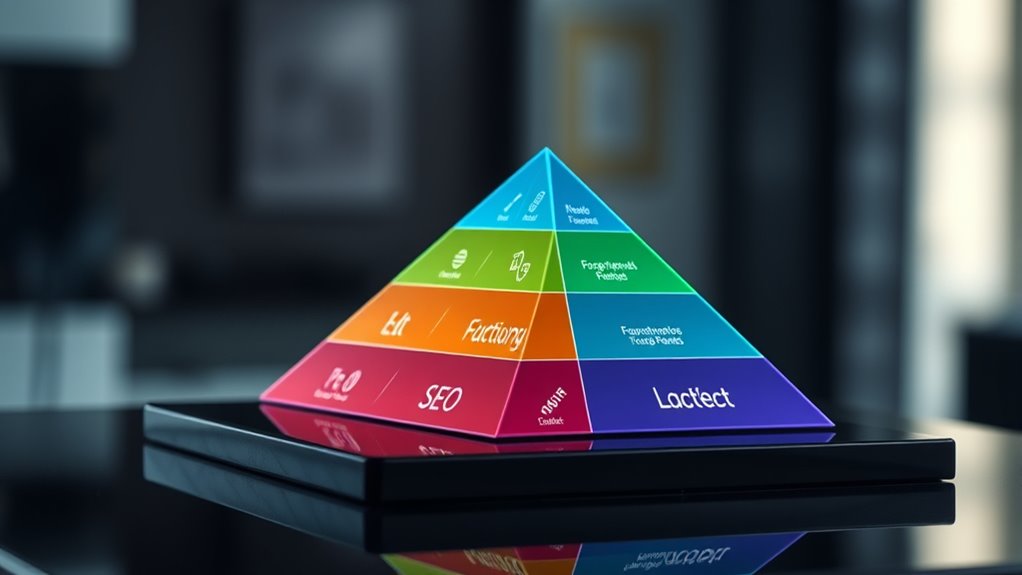Start by fixing your website’s technical foundation. Guarantee it loads quickly, is mobile-friendly, and uses HTTPS for security. Organize your site structure with clear URLs and easy navigation. These elements are critical because they allow search engines to crawl, index, and understand your site effectively. Without a solid technical base, content and backlinks won’t make much impact. Keep going, and you’ll discover the full sequence for building a successful SEO strategy.
Key Takeaways
- Prioritize fixing website speed, mobile-friendliness, and HTTPS to establish a solid technical foundation.
- Ensure a clear site structure with logical hierarchy and clean URLs to facilitate crawling and indexing.
- Address and resolve technical issues like broken links and crawl errors before focusing on content.
- Develop high-quality, relevant content optimized with keywords to attract and engage users.
- Build a strong backlink profile through natural outreach and content promotion for long-term SEO success.

Are you unsure where to focus your efforts to improve your website’s visibility? The truth is, with so many aspects of SEO, it’s easy to feel overwhelmed. That’s where understanding the pyramid of SEO priorities can help. Think of your SEO efforts as building a structure: you need a solid foundation before adding the decorative touches. Starting at the base ensures your site is technically sound, which is essential before moving on to content and backlinks. If your site isn’t technically optimized, no amount of content or link-building will make a noteworthy difference. Search engines need to be able to crawl, index, and understand your site efficiently. This means ensuring your website loads quickly, has a mobile-friendly design, uses secure HTTPS protocols, and has a clear, logical site structure with clean URLs. Fixing these technical issues first creates a strong foundation that allows the rest of your SEO efforts to succeed.
Once your technical foundation is solid, you should turn your attention to your website’s content. Content is what attracts visitors and keeps them engaged. Focus on creating high-quality, relevant, and valuable content tailored to your target audience. Keyword research is vital here—understand what your audience is searching for and incorporate those keywords naturally into your content. Don’t just stuff keywords; instead, aim for thorough, well-written pages that answer common questions or solve problems your audience faces. Content optimization also includes proper use of headers, meta descriptions, and internal links, which help search engines understand your content better. The goal is to provide a great user experience while signaling to search engines that your site is authoritative and relevant.
After your technical foundation and content are in good shape, you should prioritize building backlinks. These act as votes of confidence from other sites, showing search engines that your content is trustworthy and valuable. Focus on earning links naturally through outreach, guest posting, creating share-worthy content, and engaging with industry influencers. Remember, quality beats quantity—one strong, relevant backlink is worth more than multiple low-quality ones. As your backlink profile grows, your site’s authority increases, which can considerably boost your rankings. However, don’t neglect ongoing efforts like content updates, technical maintenance, and user experience improvements. SEO is a continuous process, but by following this pyramid approach—starting with technical health, then content, and finally backlinks—you set yourself up for sustainable success. Prioritize your efforts wisely, and you’ll see steady, meaningful progress in your website’s visibility.
Frequently Asked Questions
How Often Should I Revisit My SEO Priorities?
You should revisit your SEO priorities at least every three to six months. Regularly checking permits you to adapt to algorithm updates, changes in your website’s performance, and new competition. Keep an eye on your analytics, ranking fluctuations, and user behavior. If you notice significant shifts or new opportunities, don’t hesitate to review your strategy sooner. Staying proactive ensures your SEO efforts stay aligned with your goals and maximize results.
Can I Fix SEO Issues Without Professional Help?
Yes, you can fix SEO issues without professional help, especially if you stay informed and use user-friendly tools. Start by identifying obvious problems like broken links, slow loading pages, or missing meta descriptions. Use free tools like Google Search Console or SEO plugins to spot issues. Follow online guides and tutorials to implement fixes step-by-step. With patience and persistence, you can improve your SEO effectively on your own.
Which SEO Metric Is the Most Important?
You should focus on organic traffic as your top SEO metric. For example, a small online store increased its sales by optimizing for relevant keywords, which boosted its organic visits. When your organic traffic rises, it indicates that your content is reaching more people actively searching for your products or services. Tracking this metric helps you understand if your SEO efforts translate into real-world results.
How Long Does It Take to See SEO Improvements?
You can expect to see SEO improvements within a few weeks to a few months, depending on the changes you make. Quick wins, like optimizing meta descriptions or fixing broken links, often show results in a few weeks. More significant changes, such as content updates or technical fixes, may take three to six months to fully impact your rankings. Stay consistent and patient, and you’ll notice steady progress over time.
Should I Prioritize Mobile or Desktop SEO First?
You should prioritize mobile SEO first, as it’s the foundation that holds up your entire digital presence. Think of it as building a house on solid ground; if your mobile experience isn’t optimized, your whole website suffers. Search engines favor mobile-friendly sites, and most users browse on their phones. Fix mobile issues first, then move on to desktop, ensuring your site performs seamlessly across all devices.
Conclusion
Think of your SEO efforts as building a sturdy pyramid. If you skip the foundation—your website’s technical health—everything else crumbles. Fix the core issues first, then layer on content and backlinks like bricks rising higher. When you prioritize wisely, your site becomes a solid monument that attracts and holds visibility. Remember, without a strong base, even the most beautiful top can’t stand tall. Start at the bottom, and watch your SEO rise skyward.









